工业工程专业英语PPT(共39页)
Chapter 7 Ergonomics 工业工程专业英语 教学课件
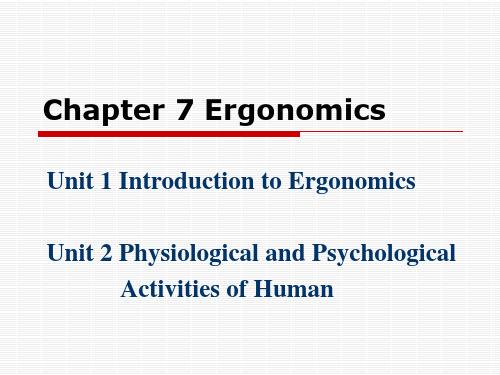
1. Physiological Aspects of Human Performance
The principles of reducing the risk of injury:
➢ All work activities should permit the worker to adopt several different, but equally healthy and safe postures;
Unit 2 Physiological and Psychological Activities of Human
1. Physiological Aspects of Human Performance 2. Anthropometry 3. Percentile 4. Application of Anthropometry 5. Impacts of Working Environment 6. Definition and Goal of Engineering Psychology 7. Effects of Working Environment on Safety 8. Mental Health 9. Human Interface with the World of Work
3. Percentile
Percentiles are shown in anthropometry tables and they tell you whether the measurement given in the tables relates to the 'average' person, or someone who is above or below average in a certain dimension.
工业工程专业英语 周跃进
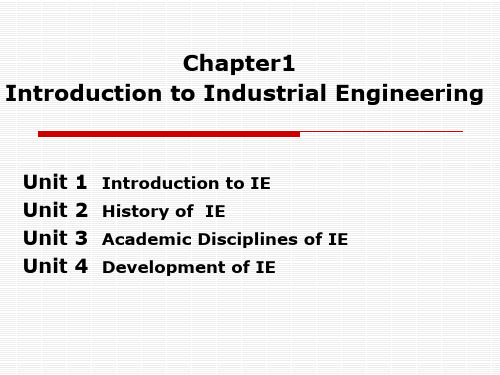
Unit Unit Unit Unit
1 2 3 4
Introduction to IE
History of IE
Academic Disciplines of IE Development of IE
Origin and Definition of Industrial Engineering
Modern era of engineering
Beginning in 1750 ,Engineering schools appeared in France in the eighteenth century.
The term civil engineer was first used in 1750 military engineering civil engineering mechanical engineering: steam engine electrical science:electricity and magnetism
Formulation of Industrial Engineering
Frank B. Gilbreth (吉尔布雷斯,1868-1924) the identification, analysis, and measurement of fundamental motions involved in performing work (motion study) This was a fundamental step in the development of industrial engineering as profession based on ―science‖ rather than ―art.‖
工业工程专业英语-周跃进
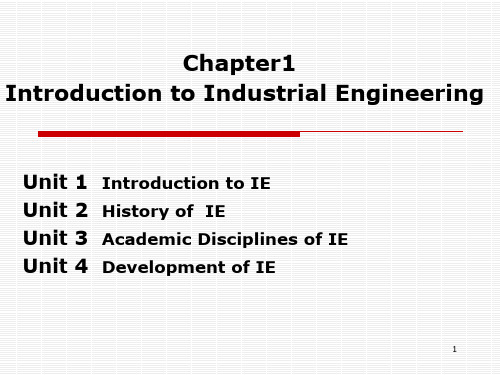
Understanding the definition of IE
Discipline character: Engineering tech. Research object: systems (macro/micro) Theory & methods: mathematics, natural
1
Origin and Definition of Industrial Engineering
Manufacturing Services Origin of IE Definition of IE
2
Manufacturing
Manufacturing is defined as making of articles by physical labor or machinery,
9
Modern era of engineering
Beginning in 1750 ,Engineering schools appeared in France in the eighteenth century.
The term civil engineer was first used in 1750 military engineering civil engineering mechanical engineering: steam engine electrical science:electricity and magnetism
7
Science
Science is concerned with the quest for basic knowledge.
e.g.:Mathematics Physics Chemistry Biology Social science (Behavior science, psychology,
Chapter 10 Human Resources Management 工业工程专业英语 教学课件
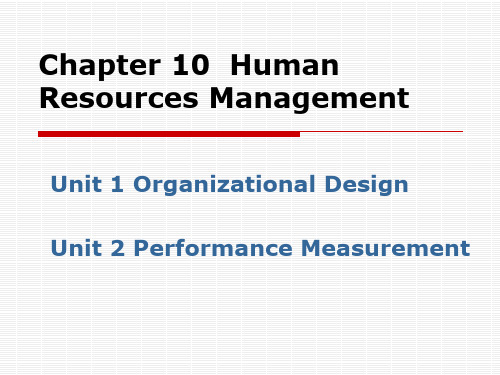
5. Guide for Designing an EWP
➢ Performance Evaluation ➢ Employee Development Results ➢ Overall Results Assessment and Rating
Earned ➢ Review of Performance Evaluation
3. Principles of Performance
Management
To identify individual and/or team objectives and measures linked to the agency's mission and strategic objectives.
➢ Position Identification Information ➢ Work Description & Performance Plan ➢ Employee Development Plan ➢ Review of Work Description/Performance Plan
4. Instructions for Completing EWP
Unit 2 Performance Measurement
1. Aim of Performance Measurement 2. Basic Terms of Performance
Management 3. Principles of Performance Management 4. Ratings of Performance Management 5. Performance Management Process 6. Key Benefits of Performance
工业工程专业英语

Lesson 3 CAM1. Introduction1。
景区简介Computer-aided manufacturing involves the use of computers and computer technology to assist in all the phases of manufacturing a product, including process and production planning, machining, scheduling, management, and quality control. Because of the benefits, computer- aided design and computer-aided manufacturing are often combined into CAD/CAM systems, show as Figure 3.1.计算机辅助制造涉及使用计算机和计算机技术辅助生产产品的所有阶段,包括工艺和生产计划,加工,调度,管理,质量控制。
由于利益,计算机辅助设计和计算机辅助制造经常CAD /CAM系统结合,显示如图3.1。
Figure 3.1 Information flow chart in CAD/CAM application图3.1信息流图在CAD / CAM应用This combination allows the transfer of information from the design stage into the stage of planning for the manufacture of a product, without the need to reenter the data on part geometry manually. The database developed during CAD is stored, then it is processed further, by CAM, into the necessary data and instructions for operating and controlling production machinery, material-handling equipment, and automated testing and inspection for product quality.这种组合允许从设计阶段的信息传递到规划阶段进行产品的制造,而不需要重新输入数据上的零件的几何形状手动。
工业工程专业英语chapter3manufacturingsystem.ppt
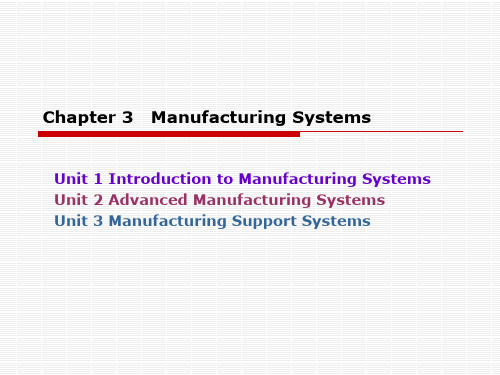
Definition of Manufacturing System
We define a manufacturing system to be a collection of integrated equipment and human resources, whose function is to perform one or more processing and/or assembly operations onl, part, or set of parts.
Chapter 3 Manufacturing Systems
Unit 1 Introduction to Manufacturing Systems Unit 2 Advanced Manufacturing Systems Unit 3 Manufacturing Support Systems
Definition of Manufacturing System
The integrated equipment includes production machines and tools, material handling and work positioning devices, and computer systems.
教学要求:
了解制造系统的含义,制造系统的各个组成部分 掌握几种典型的制造系统集成组技术、柔性制造系统、敏捷制造 等先进制造系统各自应用范围及特点。
了解CAD,CAM,CAPP等辅助制造系统在各种制造系统中的 应用。
本章共两次作业(作业5,作业6)
本章专业词汇
automation:自动化 material handling :物料搬运 synthesize:综合 integrated equipment:集成设备 raw material:原材料 positioning device:定位装置 semi-automatic:半自动化 full automated:全自动化 family:簇 production line:生产线 fixture:固定设备、夹具 hardware:硬件 machine tool:机床 lathe:车床 milling machine:铣床 drill press:钻床 workstation:工作站 portable powered tool:便携式电动工具 assembly line:装配线 machine cell:机器单元 discrete:离散的 ancillary:辅助的、附属的 work unit:工件 mechanized:机械化的 pallet:托盘 tote bin:搬运箱 vicinity:邻近 workhead:工作台、机台 workholder:工件夹具 orient:定向 clamp:夹住 chuck:卡盘
工业工程英语
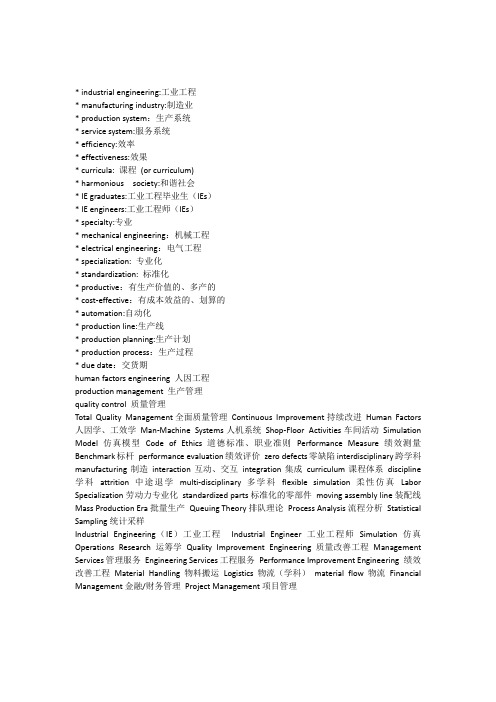
* industrial engineering:工业工程* manufacturing industry:制造业* production system:生产系统* service system:服务系统* efficiency:效率* effectiveness:效果* curricula: 课程(or curriculum)* harmonious society:和谐社会* IE graduates:工业工程毕业生(IEs)* IE engineers:工业工程师(IEs)* specialty:专业* mechanical engineering:机械工程* electrical engineering:电气工程* specialization: 专业化* standardization: 标准化* productive:有生产价值的、多产的* cost-effective:有成本效益的、划算的* automation:自动化* production line:生产线* production planning:生产计划* production process:生产过程* due date:交货期human factors engineering 人因工程production management 生产管理quality control 质量管理Total Quality Management全面质量管理Continuous Improvement持续改进Human Factors 人因学、工效学Man-Machine Systems人机系统Shop-Floor Activities车间活动Simulation Model仿真模型Code of Ethics道德标准、职业准则Performance Measure绩效测量Benchmark标杆performance evaluation绩效评价zero defects零缺陷interdisciplinary跨学科manufacturing制造interaction互动、交互integration集成curriculum课程体系discipline 学科attrition中途退学multi-disciplinary多学科flexible simulation柔性仿真Labor Specialization劳动力专业化standardized parts标准化的零部件moving assembly line装配线Mass Production Era批量生产Queuing Theory排队理论Process Analysis流程分析Statistical Sampling统计采样Industrial Engineering(IE)工业工程Industrial Engineer工业工程师Simulation仿真Operations Research运筹学Quality Improvement Engineering质量改善工程Management Services管理服务Engineering Services工程服务Performance Improvement Engineering 绩效改善工程Material Handling物料搬运Logistics物流(学科)material flow物流Financial Management金融/财务管理Project Management项目管理Industrial engineering is a branch of engineering that concerns with the development, improvement, implementation and evaluation of integrated systems of people, money, knowledge, information, equipment, energy, material and process. It also deals with designing new prototypes to help save money and make the prototype better. Industrial engineering draws upon the principles and methods of engineering analysis and synthesis, as well as mathematical, physical and social sciences together with the principles and methods of engineering analysis and design to specify, predict and evaluate the results to be obtained from such systems. In lean manufacturing systems, Industrial engineers work to eliminate wastes of time, money, materials, energy, and other resources.Industrial engineering is also known as operations management, management science, systems engineering, or manufacturing engineering; a distinction that seems to depend on the viewpoint or motives of the user. Recruiters or educational establishments use the names to differentiate themselves from others. In healthcare, for example, industrial engineers are more commonly known as management engineers or health systems engineers.The term "industrial" in industrial engineering can be misleading. While the term originally applied to manufacturing, it has grown to encompass virtually all other industries and services as well. The various topics of concern to industrial engineers include management science, financial engineering, engineering management, supply chain management, process engineering, operations research, systems engineering, ergonomics, value engineering and quality engineering.Examples of where industrial engineering might be used include designing a new loan system for a bank, streamlining operation and emergency rooms in a hospital, distributing products worldwide (referred to as Supply Chain Management), and shortening lines (or queues) at a bank, hospital, or a theme park. Industrial engineers typically use computer simulation, especially discrete event simulation, for system analysis and evaluation.工业工程是一个涉及人们、资金、知识、信息、设备、能源、材料和过程集成系统的开发、改进、实施和评价的工程分支。
工业工程专业英语
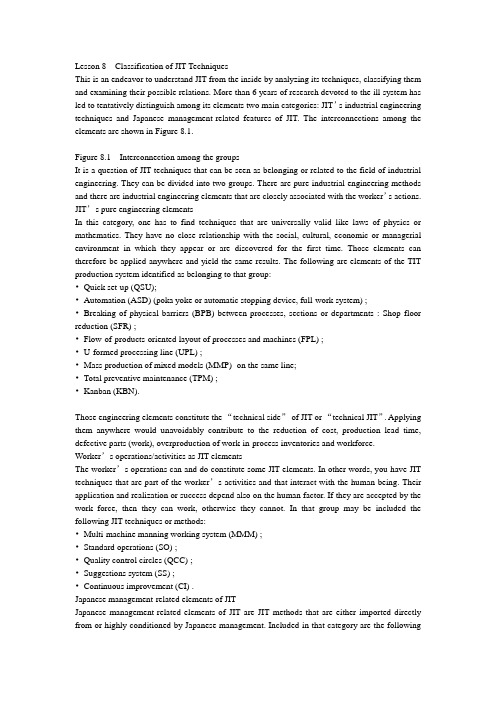
Lesson 8 Classification of JIT TechniquesThis is an endeavor to understand JIT from the inside by analyzing its techniques, classifying them and examining their possible relations. More than 6 years of research devoted to the ill system has led to tentatively distinguish among its elements two main categories: JIT’s industrial engineering techniques and Japanese management-related features of JIT. The interconnections among the elements are shown in Figure 8.1.Figure 8.1 Interconnection among the groupsIt is a question of JIT techniques that can be seen as belonging or related to the field of industrial engineering. They can be divided into two groups. There are pure industrial engineering methods and there are industrial engineering elements that are closely associated with the worker’s actions. JIT’s pure engineering elementsIn this category, one has to find techniques that are universally valid like laws of physics or mathematics. They have no close relationship with the social, cultural, economic or managerial environment in which they appear or are discovered for the first time. Those elements can therefore be applied anywhere and yield the same results. The following are elements of the TIT production system identified as belonging to that group:•Quick set-up (QSU);•Automation (ASD) (poka yoke or automatic stopping device, full-work system) ;•Breaking of physical barriers (BPB) between processes, sections or departments : Shop floor reduction (SFR) ;•Flow-of-products-oriented layout of processes and machines (FPL) ;•U-formed processing line (UPL) ;•Mass production of mixed models (MMP) -on the same line;•Total preventive maintenance (TPM) ;•Kanban (KBN).Those engineering elements constitute the “technical side”of JIT or “technical JIT”. Applying them anywhere would unavoidably contribute to the reduction of cost, production lead time, defective parts (work), overproduction of work-in-process inventories and workforce.Worker’s operations/activities as JIT elementsThe worker’s operations can and do constitute some JIT elements. In other words, you have JIT techniques that are part of the worker’s activities and that interact with the human being. Their application and realization or success depend also on the human factor. If they are accepted by the work force, then they can work, otherwise they cannot. In that group may be included the following JIT techniques or methods:•Multi-machine manning working system (MMM) ;•Standard operations (SO) ;•Quality control circles (QCC) ;•Suggestions system (SS) ;•Continuous improvement (CI) .Japanese management-related elements of JITJapanese management-related elements of JIT are JIT methods that are either imported directly from or highly conditioned by Japanese management. Included in that category are the followingtechniques:•Breaking of administrative barriers (BAB) between processes from the point of view of the paper work and work function definition;•Autonomation (ADW) (decision by worker to stop the line) ;•Job rotation (JR) ;•On-the-job training (OJT).BAB means eliminating the paper work that has to be completed before the move of products from one station or process to another or from one section to another takes place. ADW refers to an “autonomous”worker capable of stopping, based on his own judgment, the production line in case of trouble occurrence.It is worth pointing out that autonomation and the breaking of barriers each have two assets: a technical and a managerial aspect. Therefore, they have been mentioned as JIT elements pertaining to industrial engineering as well as to Japanese management.Is the classification justifiable?One may wonder why the human-related elements have not been dealt with as a sub-group in the group of management features of JIT. The multi-machine handling seems to be too technical to be classified in the category of management-related features of JIT. It has been thought of as a set of technical actions, motions and operations requiring technical skills that do not have much in common with the pure management features. There is a strong influence from the Japanese management system on the multi-machine working system. This occurs because of similarities of situations one finds in both the Japanese management and JIT systems. But MMM remains a technique of industrial engineering.The same question may be also raised about QCC, SS and CI. Are they not Japanese management-related elements of JIT? QCC, SS and CI are now so wide-spread in almost all kinds of Japanese companies, regardless of their respective industry, that they may be thought of as management features that JIT has adopted. That would be an error of perception. One should remember that QCC, for example, did not proceed or develop from the well-known small groups that are recognized as being specific to Japanese management. They have their origins in the quality control ideas introduced in Japan by Dr. Deming, and in the famous zero defects of NASA. The notions of zero defects and quality control evoke the shop floor environment and at the same time suggest the idea of CI. Suggestions for CI are closely related to QCC, and can even be seen as an emanation of QCC. The main difference between the two elements is that SS may involve either an individual or a group while QCC is always a matter of a group or a team.This article attempts to put into the category of management-related techniques of JIT only the “raw”features of Japanese management. Raw referring to the management characteristics that are found unchanged in JIT (e. g. JR). Those elements are found not only in the factory management but in any kind of Japanese company regardless of the type of industry.There are reasons the other side of autonomation among management features of JIT are included. At first, it is sure that autonomation, as a whole, may sound too technical. This is true when itrefers only to machines and processes. But when applied to the person of the worker, it loses its technical resonance. An autonomous worker refers only to an officially recognized responsible and trusted worker. Such a worker is not the only one confined in the production shop floor and who deals primarily with machines. The Japanese office worker is also very autonomous because he is given the powers to perform many duties that in other countries are in the sphere of the management authorities. Take, for example, the simple case of student’s academic record transcripts. Both in Zaire and in Japan, they bear the stamp and I or signature of the dean. The main difference is that in Zaire the dean signs it himself while in Japan the dean’s name is stamped by a clerk.SummaryJIT’s pure industrial elements seem to make up the core of that production system. However workers’operations and management features that have become JIT elements also play an important role. JIT is a complex reality whose effectiveness depends upon a wide range of parameters.Should one want to have the full JIT successfully carried out, he has a much harder task, since there are more steps to go through methodically and maybe simultaneously or sequentially. A partial implementation of JIT, say the “technical”JIT, is less demanding and it has more chance of being fruitful because there are fewer steps to undertake. It would, however, have only limited results.In either case, it should be emphasized that skipping a conditioning step may have destructive effects. Switching to the mass production of mixed models would never work and would be costly if there is no quick setup and no defect-free production.From the practical point of view, the figures can fulfill the role of either instruments for evaluating JIT or instructions for JIT implementation. Why did you succeed or fall, partially or completely, in implementing JIT at your company? The Figures can provide some answers to this question. By showing causal links between JIT elements, the Figures suggest some necessary steps to follow while switching to the JIT production and can prevent or minimize the risk of inadvertently skipping important steps.课8 JIT技术分类这是一个从内部努力理解JIT通过分析其技术,分类并分析其可能的关系。
工业工程专业英语 PPT

Services
Health-care delivery systems Transportation systems Governments Banks Departments and supermarkets
Formulation of Industrial Engineering
Eli Whitney (1765-1825)
American inventor and manufacturer whose invention of the cotton gin (1793) revolutionized the cotton industry. He also established the first factory to assemble muskets with interchangeable parts, marking the advent of modern mass production.
Charles Babbage (巴贝奇,1792-1871) British mathematician and inventor of an analytical machine based on principles similar to those used in modern digital computers. Division of labor, labor relations
Formulation of Industrial Engineering
Henry Laurence Gantt (1861-1919)
American engineer
Gantt chart
工业工程专业英语Chapter8QualityManagement

statistic:统计的
six sigma methodology: 6δ法
standard deviation:标准偏差
division:部门、分配、分开
Unit 1 Quality Standards and Quality Control
1. Definitions of Quality 2. Quality in Manufacturing 3. Quality in Service 4. ISO 9000 Series Standards 5. Rules of Certification to QMS 6. Steps of Certification to QMS
Chapter 8 Quality Management
Unit 1 Quality Standards and Quality Control
Unit 2 Quality Management and Quality Cost
计划学时:4学时
教学内容:
4学时,精读,逐句翻译,掌握专业词汇
9. Key Elements of Six Sigma Methodology
The key elements of Six Sigma are:
Customer Satisfaction Defining Processes Defining Metrics and Measures for Processes Using and Understanding Data and Systems Setting Goals for Improvement Team Building and Involving Employees
工业工程专业英语电子版U1
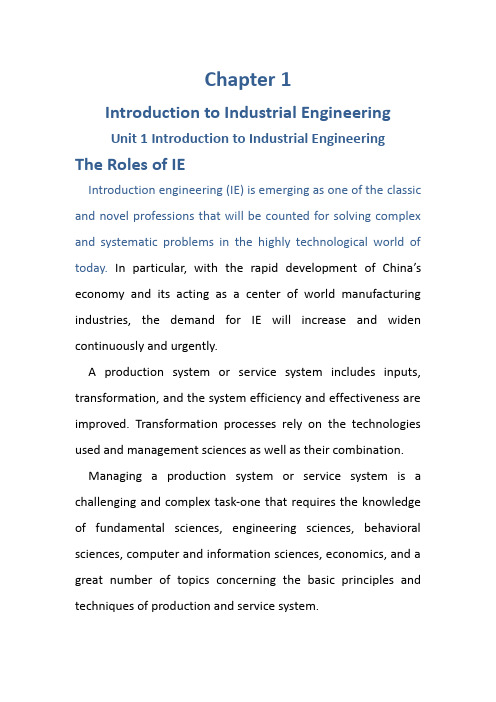
Chapter 1Introduction to Industrial EngineeringUnit 1 Introduction to Industrial Engineering The Roles of IEIntroduction engineering (IE) is emerging as one of the classic and novel professions that will be counted for solving complex and systematic problems in the highly technological world of today.In particular, with the rapid development of China’s economy and its acting as a center of world manufacturing industries, the demand for IE will increase and widen continuously and urgently.A production system or service system includes inputs, transformation, and the system efficiency and effectiveness are improved. Transformation processes rely on the technologies used and management sciences as well as their combination. Managing a production system or service system is a challenging and complex task-one that requires the knowledge of fundamental sciences, engineering sciences, behavioral sciences, computer and information sciences, economics, and a great number of topics concerning the basic principles and techniques of production and service system.The Demand for IE GraduatesIndustrial engineering curricula are designed to prepare the students to meet the challenges of the future for the construction of Chinese economic and harmonious society. Many IE graduates (IEs) will, indeed, design and run modern manufacturing system and facilities. Others will select to engage in service activities such as health-care delivery, finance, logistics, transportation, education, public administration, or consulting and so on.The demand for IE graduates is strong and growing each year. In fact, the demand for IEs greatly exceeds the supply. This demand/ supply imbalance is greater for IE than for any other engineering or science disciplines and is projected to exist for many years in the future. Therefore, over 165 universities or colleges opened IE program in China in 2006.The Objectives of the TextbookThe main purpose of this textbook is to introduce systematical theories and advanced techniques and methodologies of the relevant subjects of industrial engineering as well as their English expression. The other aim of the textbook is to strengthen and improve student’s the ability of reading and comprehension of specialized English literaturesrelated to industrial engineering.Engineering and ScienceHow did the two words “industrial”and “engineering”get combined to form the term “industrial engineering”? What is the relationship between industrial engineering and other engineering disciplines, to business management, or the social sciences?To understand the role of industrial engineering in today’s economic and knowledge-based era, it is beneficial to learn the historical developments that were hopeful in the evolution of IE. There are many ways to write a historical development of engineering. The treatment in this unit is brief because our interest is in reviewing the significances of engineering development, particularly those leading to industrial engineering as a specialty. More complete histories are available in the reference.Engineering and science have developed in a parallel, complementary fashion, although they are not always at the same pace. Whereas science is concerned with the quest for basic knowledge, engineering is concerned with the application of scientific knowledge to the solution of problems and to the quest for a “better life”. Obviously, knowledge cannot beapplied until it is discovered, and once discovered, it will soon be put to use. In its efforts to solve problems, engineering provides feedback to science in areas where new knowledge is needed. Thus, science and engineering work hand in hand. Engineering Applications-ToolsAlthough “science”and “engineering”each have distinguishing features and are regarded as different disciplines, in some cases a “scientist”and an “engineer”might be the same person. This was especially true in earlier times when there were very few means of communicating basic knowledge. The person who discovered the knowledge also put it to use. We naturally think of such outstanding accomplishments as the pyramids in Egypt, the Great Wall of China, the Roman construction projects, and so on, when we recall early engineering accomplishments. Each of these involved an impressive application of fundamental knowledge.Just as fundamental, however, were accomplishments that are not as well known. The included plant, the bow, the wheel, the corkscrew, the waterwheel, the sail, the simple lever, and, many other developments were very hopeful in the engineer’s efforts to provide a better life.Engineering BasisAlmost all engineering developments prior to 1800 had to do with physical phenomena: such as overcoming friction, lifting, storing, hauling, constructing, fastening. Later developments were concerned with chemical and molecular phenomena: such as electricity, properties of materials, thermal processes, combustion, and other chemical processes.Fundamental to almost all engineering developments were the advances made in mathematics. Procedures for accurately measuring distances, angles, weight, and time were necessary for almost all early engineering accomplishments. As these procedures were refined, greater accomplishments were realized.Another very important contribution of mathematics was the ability to represent reality in abstract terms. A mathematical model of a complex system can be manipulated such that relationships between variables in the system can be understood. The simple relationships commonly called the Pythagorean theorem is equaled is such an example. This theorem says that the hypothenuse of a right triangle is equaled as the squares of the adjacent sides. The use of abstract models representing complex physical systems is a fundamental tool of engineers.As a final comment on early development, let us pay more attention to an early development that did not occur. The missing early development is related to the behavioral sciences. The understanding of human behavior has lagged greatly behind developments in the mathematical, physical, and chemical sciences. This is important to industrial engineers because the systems designed by IEs involve people as one of the basic components. The lake of progress in behavioral science has impeded the industrial engineer in his efforts to design optimal systems involving people.The Modern Era of EngineeringBased on reference, it defines the modern era of engineering as beginning in 1750, even though there were many important developments between 1400 and 1750. There are two reasons to choose 1750 as the beginning of modern engineering:(1)Engineering schools appeared in France in the eighteenthcentury.(2)The term civil engineer was first used in 1750.Civil EngineeringPrinciples of early engineering were first learned in military colleges and were concerned primarily with road, bridge and fortifications construction. This kind of academic training wasreferred to as military engineering. When some of the same principles were applied to nonmilitary attempt, it was natural to call them as civilian engineering, or simply civil engineering. Mechanical EngineeringWith the development of civil engineering, the relevant disciplines had also developed. Interrelated advancements in the fields of physics and mathematics set up the groundwork for practical applications of mechanical principles. A significant advancement was the development of a practical steam engine that could accomplish useful work. Once such an engine was available (approximately in 1700), many mechanical devices were developed that could be driven by the engine. These efforts culminated in the emergence of mechanical engineering as a distinct branch in the early nineteenth century. Electrical EngineeringThe discovery and applications of electricity and magnetism are another example of such advancement, which were the fundamental work done in the later part of the eighteenth century. Although early scientists had known about magnetism and static electricity, an understanding of these phenomena did not start until Benjamin Franklin’s famous Kite-flying experiment in 1752. In the next 50 years the foundation ofelectrical science was built up primarily by German and French scientists.The first distinguishing application of electrical science was the development of the telegraph by Samuel Morse. Morse telegraph is a kind of telegraph that sends messages using dots and dashes or short and long sounds or flashes of light to represent letters of the alphabet and numbers. Thomas Edison’s invention of the carbon-filament lamp (which is still used today) led to widespread use of electricity for lighting purposes. This, in turn, spurred very rapid developments in the generation, transmission, and utilization of electrical energy for a variety of labor-saving purpose. Engineering who chose to specialize in this field were naturally called as electrical engineers. Chemical EngineeringAlong with the developments in mechanical and electrical technologies were accompanying developments in the understanding of substances and their properties. The science of chemistry came up, which is concerned with understanding the nature of matter and in learning how to produce desirable changes in materials. Fuels were required for the new internal combustion engines being developed. Lubricants were needed for the rapidly growing array of mechanical devices. Protectivecoatings were required for houses, metal products, ships, and so forth. Dyes were needed in the manufacture of a wide variety of consumer products. Somewhat later, artificial materials were required to carry out certain functions that could not be performed as well or at all by natural materials. This field of engineering effort naturally became known as chemical engineering.IndustryAfter making clear of science and engineering, it is time to talk about the term “industry”. A clear indication of the way in which human effort has been harnessed as a force for the commercial production of goods and services is the change in meaning of the word industry. Coming from the Latin word industria, meaning “diligent activity directed to some purpose”and its descendant, Old French industria, with the senses “activity”, ”ability”, and “a trade or occupation”, our word(first recorded in 1475) originally meant “skill”, “a device”, and “diligence” as well as “a trade”. As more and more human effort over the course of the Industrial Revolution became involved in producing goods and services for sale, the last sense of industry as well as the slightly newer sense ”systematic work or habitual employment” grew in importance, to a large extent taking overthe word. We can even speak now of the Shakespeare industry, rather like the garment industry. The sense “diligence, assiduity”, lives on, however, perhaps even to survive industry itself. From the origin of this word, we can find that it means a variety of economic or social activities.Large Scale ProductionAs industrial organizations emerged to make use of the rapidly developing array of technological innovations, the size and complexity of manufacturing units increased dramatically. Large scale production was made possible through three important concepts:(1)Interchangeability of parts.(2)Specialization of labor.(3)Standardization.Through large scale production the unit cost of consumer products was reduced dramatically.The Origination of IEThe base was now laid for a dramatic shift in the lifestyles and cultures of industrialized countries. Within nearly twenty years the People’s Republic of China and other developing countries changed largely rural, agricultural economies and societies to urban, industrialized economies and societies. Thesuddenness of this change is probably the cause of many of today’s urgent problems, for example, pollution, diseases, traffic crowding and agricultural modernization and so on. During the early part of this movement it was recognized that management practices that had worked well for small shops and farms simply were inadequate for large, complex manufacturing organization. The need for better for better management systems led to the development of what is now called industrial engineering.The Definition of Industrial EngineeringThe following formal definition of industrial engineering has been adopted by the Institute of Industrial Engineers (IIE): Industrial engineering is concerned with the design, improvement, and installation of integrated systems of people, material, information, equipment, and energy. It draws upon specialized knowledge and skill in the mathematical, physical, and social science together with the principle and methods of engineering analysis and design to specify, predict, and evaluate, the results to be obtained from such systems.As used in this context, the term industrial is intended to be interpreted in the most general way as mentioned above. Although the term industrial is often associated withmanufacturing organization, here it is intended to apply to any organization. The basic principles of industrial engineering are being applied widely in agriculture, education, hospitals, banks, government organizations, and so on.Read this definition again. Imagine any large factory that you have seen in which thousands of workers, hundreds of machines, a large variety of materials and thousands and millions of yuans must be combined in the most productive, cost-effective manner. Think about a large city that also requires millions of workers, millions of vehicles and other machinery, materials, and thousands and millions of yuans in order to deliver services required by public. Imagine how much more effectively the city could be run if the principles of industrial engineering were applied.Notes1.Industrial engineering (IE) is emerging as one of classicand novel professions that will be counted for solving complex and systematic problems in the highly technological world of today.句意:作为一种古老和新颖的专业之一,工业工程的出现将用来解决当今高度技术发展的世界所遇到的复杂的系统问题。
工业工程专业英语PPT课件

by physical labor: a person with hand tools used craft skills to make objects. by machinery: it has played an increasing role.
9
Modern era of engineering
Beginning in 1750 ,Engineering schools appeared in France in the eighteenth century.
The term civil engineer was first used in 1750 military engineering civil engineering mechanical engineering: steam engine electrical science:electricity and magnetism
7
Science
Science is concerned with the quest for basic knowledge.
e.g.:Mathematics Physics Chemistry Biology Social science (Behavior science, psychology,
5
Original of Industrial Engineering
Engineering Science Industry
6
Engineering
Engineering is concerned with the application of scientific knowledge to the solution of problems and to the quest for a “better life.”
工业工程简介PPT(共 45张)

9. 组织规划与理论 ----美国国家标准ANSI--Z94(82年)
IE常用的方法和技术
美国G.萨尔文迪主编的<工业工程手册>对美国667家公司应 用IE技术的实际情况调查统计, IE常用的方法与技术分为以下 32种:
种浪费,有效地提高生产率和经济效益的把技 术与管理有机地结合起来的一门边缘学科。
工业工程
Industrial Engineering IE
工业工程是对人员、物料、 设备、能源和信 息所组成的集成系统, 进行设计、改善和设 置的一门学科。
综合运用数学、物理学、社会科学的专门知识、 技术以及工程分析与设计的原理、方法,对由 人、物料、设备、能源、信息组成的集成系统, 进行规划、设计、评价、改进(创新)的一门 学科。
IE的意识:
成本和效率意识 问题和改革意识 工作简化和标准化意识 全局和整体化意识 以人为中心的意识。
IE特点
1. IE的核心是降低成本、提高质量和生产率。 2. IE是综合性的应用知识体系。 3. 注重人的因素是IE区别于去他工程学科的特
点之一。 4. IE的重点是面向微观管理。 5. IE是系统化技术。
IE技术
工作研究 设施规划与设计 生产计划与控制 工程经济 价值工程 质量管理与可靠性技术 工效学 组织行为学 管理信息系统 现代制造系统
工作研究
它是工业工程体系中最重要的基础技术,包括 方法研究、时间研究。
方法研究:把工作简化并定出进行此项工作的 更经济的方法和程序建立标准工作方法。
IE功能
Chapter 10 Human Resources Management 工业工程专业英语 教学课件

To promote employee and career development through creating an environment of learning and quality improvement.
To provide open and honest periodic evaluations of employee's performance.
Chapter 10 Human Resources Management
Unit 1 Organizational Design Unit 2 Performance Measurement
Unit 1 Organizational Design
1. Aim of HRM 2. Necessity of Organizational Design 3. Job Organization Structure 4. Instructions for Completing EWP 5. Guide for Designing an EWP
Earned ➢ Review of Performance Evaluation ➢ Confidentiality Statement ➢ Physical/Cognitive Requirements
Chapter 5 Production Planning and Control 工业工程专业英语 教学课件
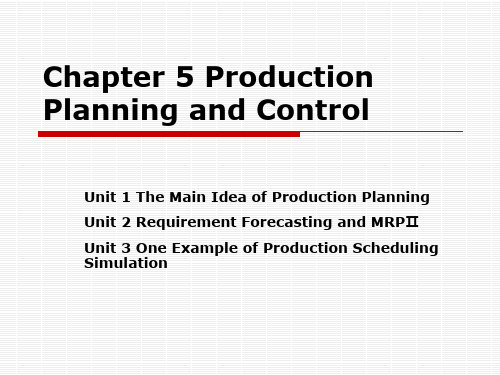
a production plan is complete specification of the amounts of each end item or final product and subassemblies produced the exact timing of the production lot sizes, and the final schedule of completion.
2. Master production schedule
The master production schedule (MPS) is a specification of the exact amounts and timing of production of each of the end items in a productive system.
1. Production Process Control
One essential issue in the design of processes is deciding how to make products or provide services.
Deciding on processes involves many different choices in marketing prepares a market analysis, how accounting bills customers, how a retail store provides services on the sales floor, and how a manufacturing plant performs its assembly operations.
工业工程专业英语复习(完整版)
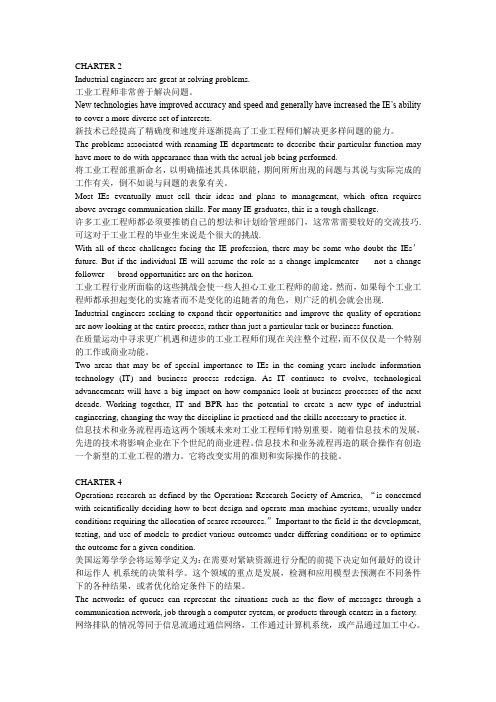
CHARTER 2Industrial engineers are great at solving problems.工业工程师非常善于解决问题。
New technologies have improved accuracy and speed and generally have increased the IE’s ability to cover a more diverse set of interests.新技术已经提高了精确度和速度并逐渐提高了工业工程师们解决更多样问题的能力。
The problems associated with renaming IE departments to describe their particular function may have more to do with appearance than with the actual job being performed.将工业工程部重新命名,以明确描述其具体职能,期间所所出现的问题与其说与实际完成的工作有关,倒不如说与问题的表象有关。
Most IEs eventually must sell their ideas and plans to management, which often requires above-average communication skills. For many IE graduates, this is a tough challenge.许多工业工程师都必须要推销自己的想法和计划给管理部门,这常常需要较好的交流技巧.可这对于工业工程的毕业生来说是个很大的挑战.With all of these challenges facing the IE profession, there may be some who doubt the IEs’future. But if the individual IE will assume the role as a change implementer --- not a change follower --- broad opportunities are on the horizon.工业工程行业所面临的这些挑战会使一些人担心工业工程师的前途。
- 1、下载文档前请自行甄别文档内容的完整性,平台不提供额外的编辑、内容补充、找答案等附加服务。
- 2、"仅部分预览"的文档,不可在线预览部分如存在完整性等问题,可反馈申请退款(可完整预览的文档不适用该条件!)。
- 3、如文档侵犯您的权益,请联系客服反馈,我们会尽快为您处理(人工客服工作时间:9:00-18:30)。
Unit 1 Quality Standards and Quality Control
7. Statistic Quality Control 8. Definition of Six Sigma Methodology 9. Key Elements of Six Sigma Methodology 10. Six Sigma in Business 11. Six Sigma in Engineering 12. Quality Control Tools
Unit 1 Quality Standards and Quality Control
1. Definitions of Quality 2. Quality in Manufacturing 3. Quality in Service 4. ISO 9000 Series Standards 5. Rules of Certification to QMS 6. Steps of Certification to QMS
trivial:琐碎的
template:模型
workshop:车间、研讨会
seminar:研讨班
demonstrate:示范、说明
preliminary:预备的、初级的
reproach:责备、谴责
forcible:强制的、有说服力的
statistic:统计的
six sigma methodology: 6δ法
Chapter 8 Quality Management
Unit 1 Quality Standards and Quality Control
Unit 2 Quality Management and Quality Cost
计划学时:4学时 教学内容:
4学时,精读,逐句翻译,掌握专业词汇
reliability:可靠性
maintainability:可维护性
fitness for use:适用性
customer satisfaction:顾客满意
specification:规范
tolerance:容许偏差
monetary:货币的、金融的
quality of design:设计质量
quality of conformance:符合性质量
Product designers must take care to neither overengineer (resulting in inefficient use of a firm's resources) nor underengineer products (resulting in poor quality).
1. Definitions of Quality
The formal definition of quality, standardized by the American National Standards Institute (ANSI) and the American Society for Quality Control (ASQC) in 1978 is "the totality of features and characteristics of a product or service that bears on its ability to satisfy given needs."
3. Quality in Service
The most important dimensions of service quality: Time Timelines Completeness Courtesy Consistency Accessibility and convenience Accuracy Responsiveness
Complete quality includes the 2 aspects: Fitness for use and conformance to specifications.
2. Quality in Manufacturing
In manufacturing, quality is an important component of all functions.
4. ISO 9000 Series Standards
The ISO 9000 series of quality management standards was developed by the ISO to set international requirements for quality management systems in underengineer:低于工程要求的
gauge:计量器
technical committee:技术委员会
international accreditation forum:国际认证
论坛
certification:认证
registrar:注册人员
audit:审计
standard deviation:标准偏差
division:部门、分配、分开
opportunity:缺陷机会 transaction:业务、交易 metrics:度量标准、规律 instructor:讲师、教练 incentive:鼓励 affiliate:隶属于 literacy:读写能力 checksheet:检查表 pareto chart:排列图 plot:以图的形式表示 histogram:直方图 dispersion:分散性 scatter diagram:散布图 observe value:观察值 cause and effect diagram:因果图 fish bone diagram:鱼骨图 specs:规范、规格 morale:士气、纪律
Unit 1 Quality Standards and Quality Control (2 学时)
Unit 2 Quality Management and Quality Cost (2 学时)
教学要求:
了解质量的概念,以及全面质量管理的相关内容。 本章共一次作业(作业10)
本章专业词汇
